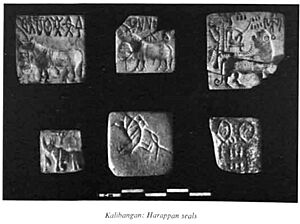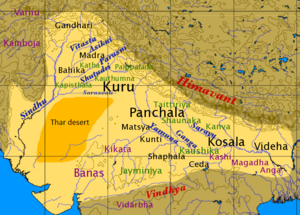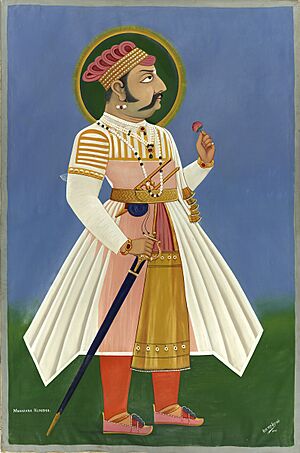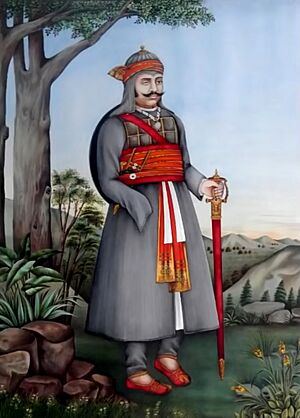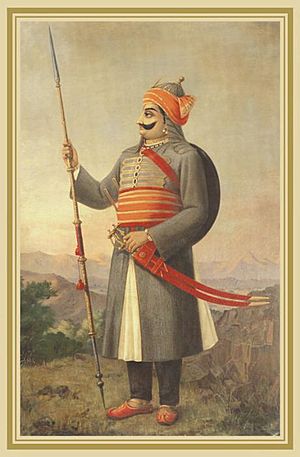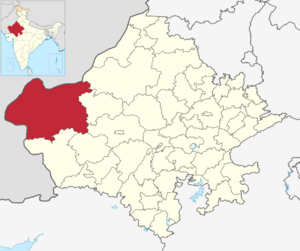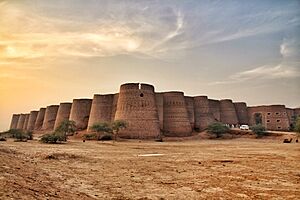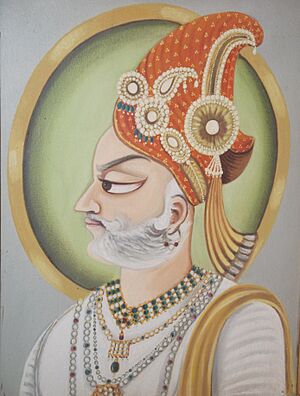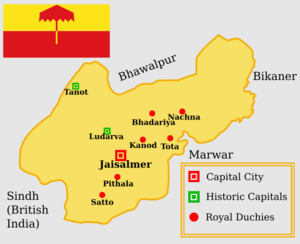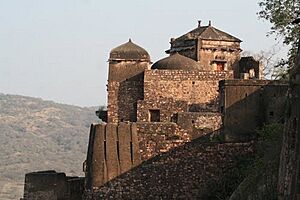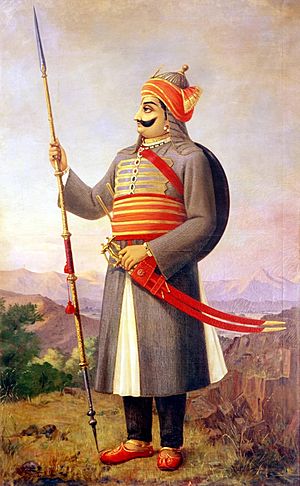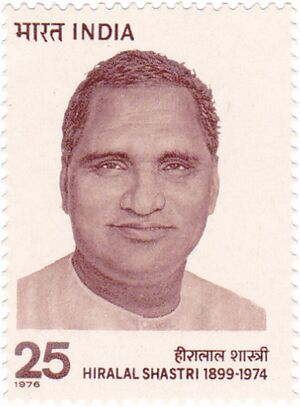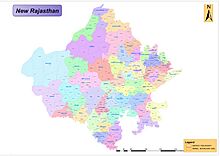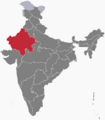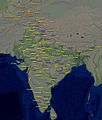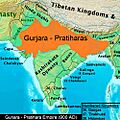History of Rajasthan facts for kids
The history of human settlement in the western Indian state of Rajasthan goes back about 100,000 years! Imagine people living there so long ago. Between 5000 and 2000 BCE, many parts of Rajasthan were home to the Indus Valley Civilization. A key site from this time is Kalibangan, where archaeologists found special fire altars, much like those found in another ancient city called Lothal.
Around 2000 BCE, a big river called Sarasvati River flowed through the Aravalli mountains in the state. During the Vedic Period, the Rajasthan area was known as Brahmavarta, meaning 'the land created by the gods'. One important kingdom from this time was the Matsya Kingdom (around 1500–350 BCE). Its main ruler was King Virata, who fought alongside the Pandavas in the famous Kurukshetra War. After the Vedic Period, many other kingdoms, like Matsya, Surasena, and Kuru, ruled parts of Rajasthan.
Later, in the early medieval period, powerful Rajput kingdoms rose up. These included the Chauhans of Ajmer, the Sisodias of Mewar, the Gurjara-Pratiharas, and the Rathores of Marwar. The Gurjara-Pratihara Empire was very important because it stopped Arab invaders from entering India between the 8th and 11th centuries. Their strong army kept the Arabs from going past Sindh for almost 300 years!
Brave Rajput leaders like Prithviraj Chauhan led armies to fight against invaders. The Gohils and Sisodias of Chittor also bravely resisted the Mughals. Famous rulers like Maharana Hammir, Maharana Kumbha, Maharana Sanga, Maharana Pratap, and Maharana Raj Singh became symbols of Rajput courage.
Rana Sanga had many victories against neighboring Muslim kingdoms, especially the Lodi dynasty of Delhi. He brought different Rajput groups together for the first time since the Second Battle of Tarain and marched against the Timurid ruler Babur. In the 16th century, Maharana Pratap also became a symbol of Rajput bravery against the Mughal invasions.
Other well-known rulers of Rajasthan include Maldeo Rathore of Marwar, Rai Singh of Bikaner, and Kachhawa rulers of Jaipur like Man Singh I and Sawai Jai Singh. Later, Jat kingdoms also grew, with Maharaja Suraj Mal being the greatest Jat ruler of Rajasthan. In modern times, Maharaja Ganga Singh of Bikaner State was famous for completing the Gang Canal Project in 1927, which brought water to the region.
Rajasthan is also famous for its amazing buildings! Some of the most important ones are the Jantar Mantar (an old observatory), Dilwara Temples, Lake Palace Resort, City Palace of Jaipur, City Palace of Udaipur, Chittorgarh Fort, Jaisalmer Havelis, and Kumbhalgarh, also known as the Great Wall of India.
The British made agreements with Rajasthan's rulers, allowing them to keep their own princely states. However, this time also saw difficult periods with famines and economic problems. The Rajputana Agency was a British office that managed these states. After India became independent in 1947, the different princely states of Rajputana joined together in seven steps to form the state of Rajasthan we know today, on November 1, 1956.
Contents
Rajasthan's History: A Timeline
Let's look at the different periods of Rajasthan's long history:
- Pre-historic Period (Stone Age): This was a very long time ago, when people used stone tools.
- Proto-historic Period (around 5000 – 1500 BCE): This period includes the Chalcolithic Age (when people started using copper) and the Bronze Age.
- Iron-Age and Ancient Period (around 1500 – 300 BCE): This includes the Vedic Period and the time of the Mahajanapadas (big kingdoms) and tribal groups. Some of these kingdoms, like Sivi and Malava, also ruled under the mighty Maurya Empire.
- Classical Period (around 300 BCE – 550 CE): During this time, many tribal kingdoms ruled on their own, even under empires like the Kushan Empire and Gupta Empire.
- Early Medieval Period (around 550 – 1000 CE): This is often called the "Rajput Period" because many Rajput families and kingdoms started to become powerful.
- Late Medieval Period (around 1000 – 1568 CE): This time was full of battles as Rajput kingdoms fought against Muslim invaders.
- Modern Period (around 1568–1947 CE):
* Mughal invasions and Rajput resistance (around 1568–1720). * Maratha influences (around 1720–1817). * Princely states of Rajputana ruled under the British Empire (around 1817 – 1947).
- Post-independence Period (around 1947 onwards): This includes the Unification of Rajasthan (around 1948 – 1956).
Early Civilizations in Rajasthan
Indus Valley Civilization
The Indus Valley Civilization, also known as the Sindhu–Saraswati civilization, was a very old civilization from the Bronze Age. It existed in the northwestern parts of India from about 3300 BCE to 1300 BCE. Its most developed period was from 2600 BCE to 1900 BCE.
- Baror in Sri Ganganagar and Karanpura in Hanumangarh are important Indus Valley Civilization sites in Rajasthan.
Kalibangan Civilization
Kalibangān is a town in the Hanumangarh district. It's believed to be located where the Drishadvati and Sarasvati River met. An Italian expert named Luigi Tessitori first noticed the ancient ruins here. The Archaeological Survey of India later dug up the site.
The findings showed that Kalibangan was a major city of the Indus Valley Civilization. It's special because of its unique "fire altars" and the world's oldest known "ploughed field." Around 2900 BCE, Kalibangan grew into a planned city.
Luigi Pio Tessitori, who discovered the site, was studying old Indian texts. He was surprised by the ruins and asked John Marshall of the Archaeological Survey of India for help. The excavations found two layers of cultures. The upper layer (Kalibangan I) was from the Harappan period, with a planned city layout. The lower layer (Kalibangan II) was an earlier, "Early Harappan" culture.
Ganeshwar Civilization
Ganeshwar is located near copper mines in the Sikar-Jhunjhunu area of Rajasthan. More than 80 other sites from the Ganeshwar-Jodhpura culture have been found. This culture existed from about 3000–2000 BCE.
When Ganeshwar was dug up in 1977, archaeologists found many copper objects. These included arrowheads, spearheads, fish hooks, bangles, and chisels. Because of its small stone tools (microliths) and other stone tools, the Ganeshwar culture is thought to be older than the main Harappan civilization.
Ganeshwar had three main periods:
- Period 1 (3800 BCE): People here were hunters and gatherers, using tools made of chert stone.
- Period II (2800 BCE): This period shows the start of metal work with copper and pottery made from fired clay.
- Period III (1800 BCE): During this time, many different types of pottery and copper items were made.
Ancient Kingdoms and Empires
Matsya Kingdom
The Matsya Kingdom was one of the first kingdoms in the Early Vedic Age. It grew into a powerful kingdom in the Later Vedic Age and was one of the sixteen "Mahajanapadas" (great kingdoms). This kingdom was located in central India, near the Kuru kingdom. It was founded by Matsya Dwaita.
The capital of Matsya was Viratanagari (today's Bairat), named after its founder, King Virata. The entire Matsya royal family fought for the Pandavas in the Kurukshetra War. King Virata and his family members bravely fought and died in the war.
Foreign Empires and Local Resistance
Around 100 to 300 CE, foreign empires like the Satraps, Kushans, and Hunas invaded and ruled some parts of western and northeastern Rajasthan. However, they faced strong opposition from local kingdoms like the Sivis, Arjunayanas, Yaudheya, and Malavas. These foreign kingdoms were later defeated by the Satavahanas and the powerful Guptas.
Rise of Rajput Kingdoms
Gurjara-Pratihara Empire
The Gurjara-Pratihara Empire was very important because it acted like a shield against Arab invaders from the 6th to the 11th century. Historians say that the strong Pratihara army stopped the Arabs from going beyond Sindh for nearly 300 years!
Nagabhata I (730–760 CE) was a key ruler. He expanded his control and set up his capital in Avanti. He also led a group of Pratihara rulers to defeat the Muslim Arabs in the Battle of Rajasthan (738 CE). An Arab writer in 851 CE described the Pratihara army as having "numerous forces" and "fine cavalry." He also noted that the Pratihara ruler was a great enemy of the Islamic faith.
Mihira Bhoja was considered the greatest ruler of this dynasty. His empire stretched far and wide, including regions like Malwa and parts of Gujarat. The Pratihara Empire finally ended when Mahmud of Ghazni captured Kannauj in 1018 CE.
The Gurjara-Pratiharas were also known for their beautiful architecture, including sculptures and carved panels. Their temples were built in an open pavilion style. The famous Khajuraho temples, built by their allies, the Chandelas, show a similar style.
- Māru-Gurjara architecture: This unique style of building developed during the Gurjara Pratihara Empire.
- Mahavira Jain temple, Osian: Built in 783 CE, this is the oldest Jain temple still standing in western India.
- Baroli temples complex: These eight temples, built by the Gurjara-Pratiharas, are located within a walled area.
Kingdom of Mewar
Guhila Dynasty

The Guhila dynasty ruled the Medapata region (modern Mewar) in Rajasthan. By the 10th century, the Guhilas of Nagda-Ahar became very powerful, and their kings took grand titles like Maharajadhiraja. They started claiming a special origin, saying their founder Guhadatta was a Brahmin who came from Anandapura.
One important ruler, Shiladitya, greatly increased the family's power. It's thought that copper and zinc mines at Jawar were opened during his rule, making the kingdom very rich. Later, Kalabhoja was identified as the famous Bappa Rawal by many historians.
In the mid-12th century, the dynasty split into two branches. The senior branch, called Rawal, ruled from Chitrakuta (modern Chittorgarh). This branch ended when Ratnasimha was defeated by the Delhi Sultanate in the 1303 Siege of Chittorgarh. The junior branch, called Rana, ruled from Sesoda and later became the Sisodia Rajput dynasty.
Sisodia Dynasty
The Sisodia dynasty started with Rahapa, a son of the Guhila king Ranasimha. After the main Guhila branch was defeated in 1303, Rana Hammir (r. 1326–1364) took back control of the region in 1326. He restarted the dynasty and became the founder of the Sisodia clan. The Sisodias regained control of their old capital, Chittor.
The most famous Sisodia rulers were Rana Hamir, Rana Kumbha (r. 1433–1468), Rana Sanga (r. 1508–1528), and Rana Pratap (r. 1572–1597). Even the Bhonsle clan, which included Maratha founder Shivaji, claimed to be related to the Sisodia family. The Rana dynasty of Nepal also claimed descent from the Ranas of Mewar.
Bhati Dynasty of Jaisalmer
The Bhati family came from Bhatner and took control of the region. The Maharajas of Jaisalmer trace their family line back to Jaitsimha, a Bhati ruler, through Deoraj, a famous prince from the 9th century. Deoraj was the first to use the title "Rawal," meaning "of the Royal house."
Legend says that Deoraj escaped a massacre at a wedding with the help of a Brahmin holy man. He later built the strong fort of Derawar. Deoraj also captured Laudrava and made it his capital.
The Bhati rulers often fought with the Rathor clans of Jodhpur and Bikaner over forts and waterholes. The Jaisalmer region was important for trade routes that connected northern India and Central Asia with ports on the Arabian Sea. Jaisalmer's location made it a perfect stop for traders and a place to collect taxes.
The Bhati rulers originally ruled parts of Afghanistan. Their ancestor Rawal Gaj is believed to have founded the city of Gajni (possibly modern-day Ghazni or Rawalpindi). His descendant Rawal Salivahan founded Sialkot. Salivahan's grandson Rawal Bhati conquered several areas, and the Bhati clan got its name from him.
Derawar Fort
Derawar Fort was first built in the 9th century CE by Rai Jajja Bhati, a Hindu Rajput ruler. It was a tribute to Rawal Deoraj Bhati, the king of Jaisalmer and Bahawalpur. The fort was first called Dera Rawal, which later became Derawar.
Foundation of Jaisalmer
In 1156, Rawal Jaisal built a new mud fort and named it Jaisalmer after himself, making it his new capital. The first Jauhar (a mass self-sacrifice by women to avoid capture) in Jaisalmer happened in 1294. This was during the rule of the Turkic ruler of Delhi, Alauddin Khalji, after the Bhatis raided a large treasure caravan.
Princely State of Jaisalmer
In 1818, the Rawals of Jaisalmer State signed a treaty with the British. This treaty protected their royal family. Jaisalmer was one of the last Rajput states to sign such an agreement.
Chauhan Dynasty
The Chauhan dynasty was a powerful Rajput family that ruled parts of Rajasthan, Haryana, Madhya Pradesh, and Delhi for over 400 years, from the 6th to the 12th century. They were known for bravely defending their homeland. The Chauhans are considered one of the four Agnivanshi Rajput clans, meaning their ancestors are said to have come from a sacred fire pit.
Some of the ruling families from the Chauhan clan included:
- Chahamanas of Shakambhari (Chauhans of Ajmer)
- Chahamanas of Naddula (Chauhans of Nadol)
- Chahamanas of Jalor (Chauhans of Jalore)
- Chahamanas of Ranastambhapura (Chauhans of Ranthambore)
Chauhans of Shakambhari
The Chauhans of Sambhar ruled parts of Rajasthan and nearby areas from the 6th to the 12th century. Their territory was known as Sapadalaksha. Until the 10th century, they were under the Pratiharas. But when the Pratihara power weakened, the Chauhan ruler Simharaja became an independent king. In the early 12th century, Ajayaraja II moved the capital to Ajayameru (modern Ajmer), which is why they are also known as the Chauhans of Ajmer.
The earliest known Chauhan king was Vasudeva in the 6th century. The Ana Sagar lake in Ajmer was built by the Chauhan ruler Arnoraja. Later Chauhan kings faced attacks from the Ghaznavids. Ajayaraja II fought off a Ghaznavid attack and defeated the Paramara king Naravarman.

Arnoraja's younger son, Vigraharaja IV, greatly expanded the Chauhan lands and captured Delhi from the Tomaras. The most famous ruler of this dynasty was Prithviraj Chauhan. He defeated several kings, including the Chandela ruler Paramardi. In 1191, he defeated the Ghurid king Muhammad of Ghor at the first Battle of Tarain. However, the next year, he was defeated and killed at the second Battle of Tarain.
After Prithviraj's defeat, Muhammad of Ghor made Prithviraj's son Govindaraja IV a ruler under him. But Prithviraj's brother Hariraja took over part of the kingdom. Hariraja was defeated by the Ghurids in 1194. Govindaraja was given the area of Ranthambore by the Ghurids, where he started a new branch of the dynasty.
The Chauhans also built many Hindu temples. Several of these were destroyed by the Ghurid invaders after Prithviraj III's defeat. Vigraharaja IV was known for supporting arts and literature. He even wrote a play called Harikeli Nataka.
Chauhans of Nadol
The Chauhans of Nadol ruled the Marwar area around their capital Naddula (modern Nadol) between the 10th and 12th centuries. They were an offshoot of the Chauhans of Shakambhari. Their founder was Lakshmana, son of the 10th-century Shakambari ruler Vakpatiraja I. These rulers fought against neighboring kingdoms and the Ghaznavids. The last ruler, Jayata-simha, was likely defeated by Qutb al-Din Aibak in 1197.
Chauhans of Jalor
The Chauhans of Jalor ruled the area around Jalore in Rajasthan between 1160 and 1311. They branched off from the Chauhans of Nadol and first ruled under the Chaulukyas of Gujarat. For a short time, they became independent, but they were eventually defeated by the Delhi Sultanate in the Siege of Jalore.
Chauhans of Ranthambore
The Chauhans of Ranthambore were a 13th-century dynasty. They ruled around their capital Ranastambhapura (Ranthambore) in Rajasthan. At first, they were under the Delhi Sultanate, but later they became independent. They were part of the Chahamanas of Shakambhari clan.
This Chauhan line was started by Govindaraja IV in 1192, after his father, Prithviraja III, was defeated by the Ghurids. Govindaraja's family gained and lost their independence from the Delhi Sultanate many times. Hammira, the last king, tried to expand his kingdom. The dynasty ended when he was defeated by the Delhi Sultan Alauddin Khalji in the Siege of Ranthambore in 1301 CE.
Later Medieval Period
Rajputs and Ghurid Invasions

In the 12th century, before the Ghurid invasions, much of the Indo-Gangetic Plain was ruled by the Rajputs. In 1191, the Rajput king of Ajmer and Delhi, Prithviraj Chauhan, brought several Rajput states together. They defeated the invading Ghurid army near Tarain in the First Battle of Tarain. However, the Rajputs did not chase the Ghurids, allowing Mu'izz al-Din to escape.
As a result, in 1192, Mu'izz al-Din returned with a huge army of Turks, Afghans, and Muslim allies. He decisively defeated the Rajput Confederacy at the Second Battle of Tarain. Prithviraj tried to escape but was captured and killed. This defeat was a major turning point in Rajasthan and Indian history. It not only crushed Rajput power in the Gangetic Plain but also firmly established a Muslim presence in northern India.
For the next four centuries, the central power in Delhi tried many times to conquer the Rajput states, but they were never fully successful. However, the Rajputs, despite sharing history and culture, were never able to unite completely to defeat their enemies for good.
The Sisodia Rajputs of Mewar led other kingdoms in resisting outside rule. Rana Hammir Singh defeated the Tughlaq dynasty and took back a large part of Rajasthan. The brave Rana Kumbha defeated the Sultans of Malwa, Nagaur, and Gujarat, making Mewar the strongest Hindu kingdom in Northern India.
Rajputana under Rana Sanga

In 1508, Rana Sanga became king after a long struggle. He was an ambitious ruler who brought Mewar to its peak of power and wealth. Rajput strength under Rana Sanga became very strong, threatening to bring back their power in Northern India. He built a large kingdom stretching from the Satluj river in Punjab to the Narmada River in the south.
In his military career, he defeated Ibrahim Lodhi at the Battle of Khatoli, freeing most of Rajasthan. He also gained control over parts of Uttar Pradesh. After another victory against Ibrahim Lodhi at the Battle of Dholpur, Sanga conquered much of Malwa and gave it to his ally Medini Rai.
Sanga also invaded Gujarat with 50,000 Rajput soldiers and his allies. He looted the Gujarat sultanate and chased the Muslim army all the way to the capital, Ahmedabad. He successfully took over northern Gujarat and appointed one of his allies to rule there. After these victories, he became the supreme ruler of Rajasthan, Malwa, and large parts of Gujarat.
After these victories, he united several Rajput states from Northern India to drive Babur out of India and bring back Hindu power in Delhi. He marched with an army of 100,000 Rajputs to fight Babur and expand his territory by taking Delhi and Agra. This battle was fought for control of Northern India between the Rajputs and the Mughals.
However, the Rajput Confederation suffered a terrible defeat at Khanwa. This was because Babur had better leadership and used modern tactics. The battle was very important because it firmly established Mughal rule in India and crushed the rising Rajput powers. It was also one of the first battles to use cannons, matchlocks, and mortars effectively.
The Battle of Khanwa also marked the last time in medieval India that the Rajputs stood united against a foreign invader. Many Rajput families lost close allies in this battle. Rana Sanga was carried unconscious from the battlefield by his allies. After he woke up, he swore not to return to Chittor until he defeated Babur and conquered Delhi. He even stopped wearing a turban as a sign of his vow. While preparing for another war against Babur, he was poisoned by his own nobles who did not want another battle. He died in Kalpi in January 1528.
After Sanga's defeat, his ally Medini Rai was defeated by Babur at the Battle of Chanderi. Babur captured Chanderi and Malwa.
Khanzadas of Mewat
The Mewat State was an independent kingdom from 1372 to 1527, with Alwar as its capital. It was ruled by the Khanzadas of Mewat, a Muslim Rajput family. They were Sunni Muslims and established their rule in Mewat in 1372. They became fully independent over time, until their rule ended in 1527.
Raja Hasan Khan Mewati came from this family, which had ruled Mewat for almost two centuries. Babur, the founder of the Mughal Empire, recognized him as the leader of 'Mewat country'. Hasan Khan Mewati played a key role in the Battle of Khanwa, where he led 5,000 soldiers alongside Rana Sanga against Babur's Mughal forces. He also rebuilt the Alwar fort in the 15th century.
Raja Hasan Khan Mewati also fought in the First Battle of Panipat, supporting Ibrahim Lodi against Babur. Even after that defeat, he remained determined and joined Rana Sanga to resist Babur's invasion. In the Battle of Khanwa, when Rana Sanga fell, Hasan Khan Mewati took command and led a strong attack with his 12,000 horse soldiers. Sadly, he was hit by a cannonball and died during the battle. His bravery and determination left a lasting legacy.
Modern Period
Mughal Invasions and Rajput Resistance
The Mughal Emperor Akbar expanded his empire into Rajputana in the 16th century. He attacked Chittor and defeated the Kingdom of Mewar in 1568. He also attacked Ranthambore and defeated the forces of Surjan Hada in the same year.
Akbar also made marriage alliances to gain the trust of Rajput rulers. He himself married the Rajput princess Jodha Bai. He gave important positions to many Rajput princes, like Man Singh I, who was one of his navaratnas (nine jewels). However, some Rajput rulers did not want to accept Akbar's rule and preferred to stay independent. Two such rulers were Udai Singh II of Mewar and Chandrasen Rathore of Marwar. They constantly fought against Akbar. This struggle was continued by Rana Pratap, Udai Singh's successor. His army met Akbar's forces at the Battle of Haldighati, where he was defeated and wounded. After that, he stayed hidden for twelve years, attacking the Mughals from time to time.
Mughal influence can be seen in the styles of Rajput painting and Rajput architecture from this period.
Rise of Jat Kingdoms
Jat Kingdom of Bharatpur
Bharatpur State, also known as the Jat Kingdom of Bharatpur, was a Hindu kingdom in northern India. It was ruled by the Sinsinwar clan of the Hindu Jats. During the reign of King Suraj Mal (1755–1763), the state earned a lot of money, about 17.5 million rupees a year.
The state of Bharatpur was formed because the Jats living around Delhi, Agra, and Mathura revolted against the Mughals. There were also conflicts between Jats and Rajputs over land rights. The Jats fought hard, but by 1691, Raja Ram Sinsini and his successor Churaman had to surrender to the Mughals. Rajaram, who also dug up and burned the remains of Akbar, is known for building a small fort at Sinsini, which was a key step in forming this kingdom.
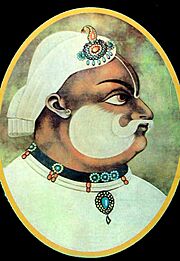
The most famous ruler of Bharatpur was Maharaja Suraj Mal. He captured the important Mughal city of Agra on June 12, 1761. He even melted the two silver doors of the famous Mughal monument, the Taj Mahal. Agra remained under Bharatpur rulers until 1774.
Jat Kingdom of Dholpur
The Kingdom of Dholpur was a kingdom in eastern Rajasthan, founded in 1806 CE by a Jat ruler named Rana Kirat Singh of Gohad. After 1818, the British placed the state under their Rajputana Agency. The Ranas ruled Dholpur until India became independent in 1947. In 1947, the kingdom joined the Union of India.
Very little is known about the early history of Dholpur. In 1505, the neighboring Gohad State of Rana Jats was founded. Dholpur was annexed by Bharatpur State from 1761 to 1775, and then by Gwalior from 1782 to 1805. On January 10, 1806, Dholpur became a British protectorate.
Maratha Influences
Starting in the 1720s, the Maratha Empire began to expand northwards, led by Peshwa Baji Rao I of Pune. This expansion brought the Maratha Empire into contact with the Rajputs. Some Rajput kingdoms willingly accepted Maratha rule, while others resisted. Rajasthan saw many campaigns by the Marathas, mostly led by the Holkars and Scindhias families.
British Influences
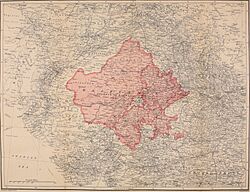
When the British East India Company arrived in the region, they created an administrative area called the Rajputana Agency. This included many different areas that had never been politically united before. This name was later changed to Rajputana Province and lasted until it was renamed Rajasthan in 1949. The Company officially recognized various states, including Ajmer-Merwara, which was directly controlled by the British. Of these areas, Marwar and Jaipur were the most important in the early 19th century.
Alliances were formed between the British Company and these princely states in the early 19th century. The states accepted British rule in exchange for local freedom and protection from the Marathas. Following the Mughal tradition, and because of its important location, Ajmer became a British Indian province. The independent Rajput states, the Muslim state of Tonk, and the Jat states of Bharatpur and Dholpur were organized into the Rajputana Agency.

In 1817–1818, the British Government signed treaties with almost all the states of Rajputana. This marked the beginning of British rule over Rajasthan, then called Rajputana.
Some of the British Princely States of the Rajputana Agency were:
- Jaisalmer State
- Bikaner State
- Jodhpur State
- Jaipur State
- Udaipur State
- Alwar State
- Kishangarh State
- Dungarpur State
- Sirohi State
- Banswara State
- Kota State
- Bundi State
- Bharatpur State
- Karauli State
- Dholpur State
These states later joined together in seven steps in 1948 to form the present state of Rajasthan in 1956.
Post-Independence Rajasthan
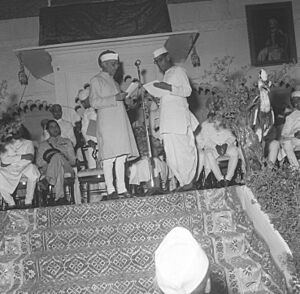
The name Rajasthan became popular in the 12th century, before the Ghurid invasions. The state was officially formed on March 30, 1949, when Rajputana joined the Dominion of India. The word Rajasthan was recognized as the state's name on January 26, 1950.
Jaipur, being the largest city, was made the capital. Jaipur was founded in 1727 by the Kacchawa ruler of Amer, Jai Singh II, after whom the city is named. During British rule, Jaipur was the capital of Jaipur State. After independence in 1947, Jaipur became the capital of the new state of Rajasthan.
How Rajasthan Was United
It took seven steps to form Rajasthan as it is today.
- First Step: In March 1948, the "Matsya Union" was formed, consisting of Alwar, Bharatpur, Dhaulpur, and Karauli.
- Second Step: Also in March 1948, Banswara, Bundi, Dungarpur, Jhalawar, Kishangarh, Kota, Pratapgarh, Shahpura, and Tonk joined the Indian union and became part of Rajasthan.
- Third Step: In April 1948, Udaipur joined the state, and the Maharana of Udaipur became the Rajpramukh (head of state). By 1948, most of the southern and southeastern states had joined.
- Fourth Step: Jaipur State and the desert kingdoms of Bikaner, Jodhpur, and Jaisalmer were still independent. For security reasons, it was important for them to join India. The princes finally agreed to sign the Instrument of Accession in March 1949. This time, the Maharaja of Jaipur, Man Singh II, became the Rajpramukh, and Jaipur became the capital. March 30 is celebrated as Rajasthan Day.
- Fifth Step: Later in 1949, the United States of Matsya (Bharatpur, Alwar, Karauli, and Dholpur) was merged into Rajasthan.
- Sixth Step: On January 26, 1950, 18 states of united Rajasthan merged with Sirohi. However, Abu and Dilwara remained part of Bombay (now Gujarat).
- Seventh Step: In November 1956, under the States Re-organisation Act, the former 'C' state of Ajmer, Abu Road Taluka (from Sirohi), and the Sunel-Tappa region (from Madhya Bharat) merged with Rajasthan. The Sironj sub-district of Jhalawar was transferred to Madhya Pradesh. This gave Rajasthan its current boundaries. The unification of Rajasthan was completed on November 1, 1956.
First Government of Rajasthan
Gurumukh Nihal Singh was appointed as the first governor of Rajasthan. Hiralal Shastri was the first nominated chief minister, taking office on April 7, 1949. He was followed by two other nominated chief ministers before Tika Ram Paliwal became the first elected chief minister on March 3, 1951.
Rajasthan Today
During the Second India–Pakistan War in September 1965, Pakistan took control of some areas of Rajasthan. These were later returned under the Tashkent Declaration. The princes of the former kingdoms were given special payments called "privy purses" and privileges to help them with their finances. In 1970, Indira Gandhi, the Prime Minister of India, decided to stop these privy purses, and they were abolished in 1971. Many former princes still use the title of Maharaja, but it is now mostly a symbol of status. Many Maharajas have turned their palaces into successful hotels, and some have entered politics. Today, a democratically elected government runs the state, with a chief minister as its executive head and a governor as the head of the state.
Currently, Rajasthan has 50 districts, 105 sub-divisions, 37,889 villages, over 350 tehsils, and 222 towns.
On March 17, 2023, the Government of Rajasthan announced the creation of 19 new districts and 3 new divisions. Jaipur and Jodhpur districts were split into urban and rural parts. This increased the number of districts to 50 and divisions to 10.
See also
- Matsya Kingdom
- Outline of Rajasthan
- List of Rajput dynasties
- List of battles of Rajasthan
- Timeline of history of Rajasthan
- List of dynasties and rulers of Rajasthan
Images for kids
-
A scene of Battle of Haldighati, fought between Mughals and Maharana Pratap.
-
Statue of Maharana Pratap in City Palace, Udaipur, the pioneer ruler of Rajasthan
-
Jantar Mantar, astronomical monuments built by Sawai Jai Singh.
-
The Minor Rock Edict 3 of Ashoka, found on the platform in front of the Bairat Temple of Viratnagar, Rajasthan.
-
Ghateshwara Mahadeva temple at the Baroli Temple Complex. The temples were built between the 10th and 11th centuries by the Gurjara-Pratihara dynasty.


